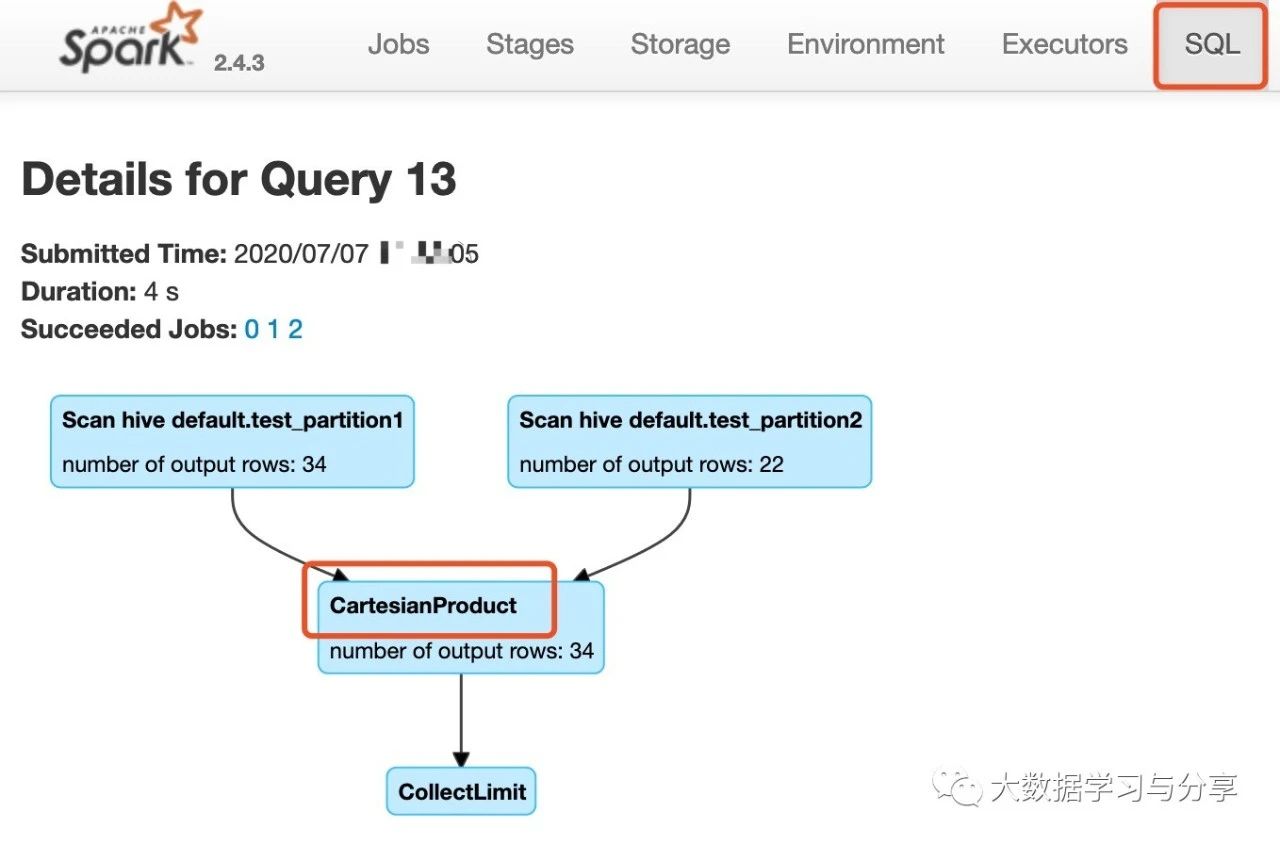【前言:如果你经常使用Spark SQL进行数据的处理分析,那么对笛卡尔积的危害性一定不陌生,比如大量占用集群资源导致其他任务无法正常执行,甚至导致节点宕机。那么都有哪些情况会产生笛卡尔积,以及如何事前"预测"写的SQL会产生笛卡尔积从而避免呢?(以下不考虑业务需求确实需要笛卡尔积的场景)】
Spark SQL几种产生笛卡尔积的典型场景
首先来看一下在Spark SQL中产生笛卡尔积的几种典型SQL:
1. join语句中不指定on条件
select * from test_partition1 join test_partition2;
2. join语句中指定不等值连接
select * from test_partition1 t1 inner join test_partition2 t2 on t1.name <> t2.name;
3. join语句on中用or指定连接条件
select * from test_partition1 t1 join test_partition2 t2 on t1.id = t2.id or t1.name = t2.name;
4. join语句on中用||指定连接条件
select * from test_partition1 t1 join test_partition2 t2 on t1.id = t2.id || t1.name = t2.name;
除了上述举的几个典型例子,实际业务开发中产生笛卡尔积的原因多种多样。
同时需要注意,在一些SQL中即使满足了上述4种规则之一也不一定产生笛卡尔积。比如,对于join语句中指定不等值连接条件的下述SQL不会产生笛卡尔积:
--在Spark SQL内部优化过程中针对join策略的选择,最终会通过SortMergeJoin进行处理。 select * from test_partition1 t1 join test_partition2 t2 on t1.id = t2.id and t1.name<>t2.name;
此外,对于直接在SQL中使用cross join的方式,也不一定产生笛卡尔积。比如下述SQL:
-- Spark SQL内部优化过程中选择了SortMergeJoin方式进行处理 select * from test_partition1 t1 cross join test_partition2 t2 on t1.id = t2.id;
但是如果cross join没有指定on条件同样会产生笛卡尔积。那么如何判断一个SQL是否产生了笛卡尔积呢?
Spark SQL是否产生了笛卡尔积?
以join语句不指定on条件产生笛卡尔积的SQL为例:
-- test_partition1和test_partition2是Hive分区表 select * from test_partition1 join test_partition2;
通过Spark UI上SQL一栏查看上述SQL执行图,如下:
可以看出,因为该join语句中没有指定on连接查询条件,导致了CartesianProduct即笛卡尔积。
再来看一下该join语句的逻辑计划和物理计划:
== Parsed Logical Plan ==
'GlobalLimit 1000
+- 'LocalLimit 1000
+- 'Project [*]
+- 'UnresolvedRelation `t`
== Analyzed Logical Plan ==
id: string, name: string, dt: string, id: string, name: string, dt: string
GlobalLimit 1000
+- LocalLimit 1000
+- Project [id#84, name#85, dt#86, id#87, name#88, dt#89]
+- SubqueryAlias `t`
+- Project [id#84, name#85, dt#86, id#87, name#88, dt#89]
+- Join Inner
:- SubqueryAlias `default`.`test_partition1`
: +- HiveTableRelation `default`.`test_partition1`, org.apache.hadoop.hive.ql.io.parquet.serde.ParquetHiveSerDe, [id#84, name#85], [dt#86]
+- SubqueryAlias `default`.`test_partition2`
+- HiveTableRelation `default`.`test_partition2`, org.apache.hadoop.hive.ql.io.parquet.serde.ParquetHiveSerDe, [id#87, name#88], [dt#89]
== Optimized Logical Plan ==
GlobalLimit 1000
+- LocalLimit 1000
+- Join Inner
:- HiveTableRelation `default`.`test_partition1`, org.apache.hadoop.hive.ql.io.parquet.serde.ParquetHiveSerDe, [id#84, name#85], [dt#86]
+- HiveTableRelation `default`.`test_partition2`, org.apache.hadoop.hive.ql.io.parquet.serde.ParquetHiveSerDe, [id#87, name#88], [dt#89]
== Physical Plan ==
CollectLimit 1000
+- CartesianProduct
:- Scan hive default.test_partition1 [id#84, name#85, dt#86], HiveTableRelation `default`.`test_partition1`, org.apache.hadoop.hive.ql.io.parquet.serde.ParquetHiveSerDe, [id#84, name#85], [dt#86]
+- Scan hive default.test_partition2 [id#87, name#88, dt#89], HiveTableRelation `default`.`test_partition2`, org.apache.hadoop.hive.ql.io.parquet.serde.ParquetHiveSerDe, [id#87, name#88], [dt#89]
通过逻辑计划到物理计划,以及最终的物理计划选择CartesianProduct,可以分析得出该SQL最终确实产生了笛卡尔积。
Spark SQL中产生笛卡尔积的处理策略
在之前的文章中《Spark SQL如何选择join策略》已经介绍过,Spark SQL中主要有ExtractEquiJoinKeys(Broadcast Hash Join、Shuffle Hash Join、Sort Merge Join,这3种是我们比较熟知的Spark SQL join)和Without joining keys(CartesianProduct、BroadcastNestedLoopJoin)join策略。
那么,如何判断SQL是否产生了笛卡尔积就迎刃而解。
1. 在利用Spark SQL执行SQL任务时,通过查看SQL的执行图来分析是否产生了笛卡尔积。如果产生笛卡尔积,则将任务杀死,进行任务优化避免笛卡尔积。【不推荐。用户需要到Spark UI上查看执行图,并且需要对Spark UI界面功能等要了解,需要一定的专业性。(注意:这里之所以这样说,是因为Spark SQL是计算引擎,面向的用户角色不同,用户不一定对Spark本身了解透彻,但熟悉SQL。对于做平台的小伙伴儿,想必深有感触)】
2. 分析Spark SQL的逻辑计划和物理计划,通过程序解析计划推断SQL最终是否选择了笛卡尔积执行策略。如果是,及时提示风险。具体可以参考Spark SQL join策略选择的源码:
def apply(plan: LogicalPlan): Seq[SparkPlan] = plan match {
// --- BroadcastHashJoin --------------------------------------------------------------------
// broadcast hints were specified
case ExtractEquiJoinKeys(joinType, leftKeys, rightKeys, condition, left, right)
if canBroadcastByHints(joinType, left, right) =>
val buildSide = broadcastSideByHints(joinType, left, right)
Seq(joins.BroadcastHashJoinExec(
leftKeys, rightKeys, joinType, buildSide, condition, planLater(left), planLater(right)))
// broadcast hints were not specified, so need to infer it from size and configuration.
case ExtractEquiJoinKeys(joinType, leftKeys, rightKeys, condition, left, right)
if canBroadcastBySizes(joinType, left, right) =>
val buildSide = broadcastSideBySizes(joinType, left, right)
Seq(joins.BroadcastHashJoinExec(
leftKeys, rightKeys, joinType, buildSide, condition, planLater(left), planLater(right)))
// --- ShuffledHashJoin ---------------------------------------------------------------------
case ExtractEquiJoinKeys(joinType, leftKeys, rightKeys, condition, left, right)
if !conf.preferSortMergeJoin && canBuildRight(joinType) && canBuildLocalHashMap(right)
&& muchSmaller(right, left) ||
!RowOrdering.isOrderable(leftKeys) =>
Seq(joins.ShuffledHashJoinExec(
leftKeys, rightKeys, joinType, BuildRight, condition, planLater(left), planLater(right)))
case ExtractEquiJoinKeys(joinType, leftKeys, rightKeys, condition, left, right)
if !conf.preferSortMergeJoin && canBuildLeft(joinType) && canBuildLocalHashMap(left)
&& muchSmaller(left, right) ||
!RowOrdering.isOrderable(leftKeys) =>
Seq(joins.ShuffledHashJoinExec(
leftKeys, rightKeys, joinType, BuildLeft, condition, planLater(left), planLater(right)))
// --- SortMergeJoin ------------------------------------------------------------
case ExtractEquiJoinKeys(joinType, leftKeys, rightKeys, condition, left, right)
if RowOrdering.isOrderable(leftKeys) =>
joins.SortMergeJoinExec(
leftKeys, rightKeys, joinType, condition, planLater(left), planLater(right)) :: Nil
// --- Without joining keys ------------------------------------------------------------
// Pick BroadcastNestedLoopJoin if one side could be broadcast
case j @ logical.Join(left, right, joinType, condition)
if canBroadcastByHints(joinType, left, right) =>
val buildSide = broadcastSideByHints(joinType, left, right)
joins.BroadcastNestedLoopJoinExec(
planLater(left), planLater(right), buildSide, joinType, condition) :: Nil
case j @ logical.Join(left, right, joinType, condition)
if canBroadcastBySizes(joinType, left, right) =>
val buildSide = broadcastSideBySizes(joinType, left, right)
joins.BroadcastNestedLoopJoinExec(
planLater(left), planLater(right), buildSide, joinType, condition) :: Nil
// Pick CartesianProduct for InnerJoin
case logical.Join(left, right, _: InnerLike, condition) =>
joins.CartesianProductExec(planLater(left), planLater(right), condition) :: Nil
case logical.Join(left, right, joinType, condition) =>
val buildSide = broadcastSide(
left.stats.hints.broadcast, right.stats.hints.broadcast, left, right)
// This join could be very slow or OOM
joins.BroadcastNestedLoopJoinExec(
planLater(left), planLater(right), buildSide, joinType, condition) :: Nil
// --- Cases where this strategy does not apply ---------------------------------------------
case _ => Nil
}
此外,在业务开发中,要不断总结归纳产生笛卡尔积的情况,形成知识文档,以便在后续业务开发中避免类似的情况出现。
除了笛卡尔积效率比较低,BroadcastNestedLoopJoin效率也相对低效,尤其是当数据量大的时候还很容易造成driver端的OOM,这种情况也是需要极力避免的。
推荐文章:
Spark SQL中Not in Subquery为何低效以及如何规避
SparkSQL与Hive metastore Parquet转换
Spark SQL解析查询parquet格式Hive表获取分区字段和查询条件
关注微信公众号:大数据学习与分享,获取更对技术干货